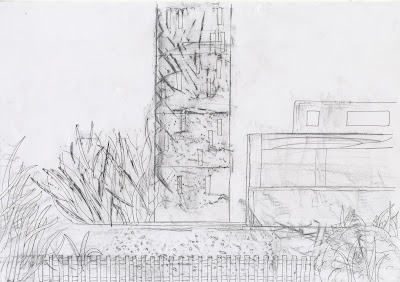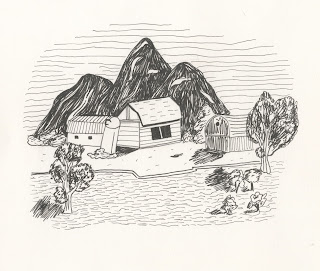To begin with I'm going to look at Steve Bell, and his use of visual metaphors. Steve Bell is a very well known political cartoonist who is know to work a lot along side the guardian. One of the most iconic visual metaphors that he has created is George Bush as a chimp. (1)
Bell likes to strip back the politicians to something to do with their image, he always draws John Major with his dull grey underpants and David Cameron frequently dressed in a condom, which adds a certain humour to his work. Bell enjoys doing this as he says;” They’re so careful about their image, which is good for a cartoonist, because you can rip their image to shreds,' he says with a smile.” (2)
So for this methodology I decided to draw Boris Johnson, Mayor of London as a fool. I think a lot of people see Johnson as a joke, and not a serious Mayor at all, I also think that a lot of this time he almost comes across as drunk in his public events. He's been known to often say random strange quotes and embarrasses himself.
And so i drew him looking a mess and drunk, with his eyes crossed. I did this to strip back his serious title of being a Mayor, and showing him in a way that conveys how serious people actually take him as well as adding humour.
For the second methodology, I’m going to look at Steve Bells use of anthropomorphism. Bell anthropomorphises certain politicians with animals they look like/ is relevant in current news. He turned Ed Miliband into a crazy panda for a visual metaphor using the animal as a source. He used the source of the panda as it was big in the news at that time that Edinburgh zoo’s pandas were failing to mate.
For this methodology, I decided to anthropomorphise Ed Miliband again, but this time into a chicken. I thought this was very fitting as not only does he look like the famous chicken characters from ‘Chicken Run’, but he also quit his role in Labour when they didn't do so well. I thought this was very cowardly- and cowardliness always has connotations with being called ‘a chicken’. (3)
Ralph Steadman uses a lot of quick and free flowing ink line work in contrast to some specific sharp lines and ink splatters. This creates a very powerful and bold image that emphasises some power in the point he's making. In this piece (4) the obvious evil character of the picture is very darkly coloured in compared to the statue of liberty, it is almost completely black compared to something almost completely white. By doing this Steadman is able to represent the meaning of bad against good straight away in colour alone.
 I chose to draw David Cameron sitting on a bomb wearing a cowboy hat, to represent his eagerness with the recent news that he's won Syria airstrikes votes (5). And so I drew the bomb with the rough black ink, and gave Cameron the creepy concentric circle eyes that Steadman gives his bad characters a lot. I also used his technique of the ink splatters around the page and the overall roughness of his style.
I chose to draw David Cameron sitting on a bomb wearing a cowboy hat, to represent his eagerness with the recent news that he's won Syria airstrikes votes (5). And so I drew the bomb with the rough black ink, and gave Cameron the creepy concentric circle eyes that Steadman gives his bad characters a lot. I also used his technique of the ink splatters around the page and the overall roughness of his style.
For the last methodology, I'm going to look at pastiche in Steve Bells work, like this piece he did with Star Wars (6). Bell uses pastiche of both famous paintings, artworks and even films within his own work to add a familiar reference to the joke and to also mock the characters further. By doing this he adds even more humour to his already humorous cartoons.
So again, I used the Syrian airstrikes as the basis of my work. I decided i wanted to use the ‘Harry Potter’ films for my pastiche, and so drew Cameron as the evil character of the film, Voldemort. In Harry Potter, Voldemort tried to kill the baby Harry Potter and so I linked that with the news of Cameron bombing Syria and peoples views that he shouldn't be wanting to kill innocent people.
I drew it in Bells similar comic strip style, and like him, tried to make the characters look a lot like their film characters, (Voldermort and Snape) with little distinctive features of the politicians of (Cameron and John Baron). To distinguish it was them I added their hair and glasses, for Baron.
By doing this, the reader can immediately see the pastiche connection with Harry Potter.
References
(1) Steve Bell, George Bush (2012)
(2) Steve Bell, (2011)
(3) Winter and Mason, (2015)
(4) Ralph Steadman, satirical cartoon of Ronald Reagon, (March 1990)
(5) Sparrow and Perraudin, (2015)
(6) Steve Bell, on Jeremy Corbyn, Labours Jedi knight, (2015)
Bibliography
Bell, S. (2012) The guardian. Available at: www.theguardian.com/commentisfree/cartoon/2012/apr/06/steve-bell-cartoon-ed-milliband-giant-panda (Accessed: 3 December 2015).
Bell, S. (2015) Steve Bell’s if ... On Jeremy Corbyn, labour's Jedi knight. Available at: http://www.theguardian.com/commentisfree/picture/2015/sep/16/steve-bells-if-on-jeremy-corbyn-labours-jedi-knight (Accessed: 12 March 2015).
Fund, A. (2006) Ralph Steadman: A retrospective. Available at: http://www.artfund.org/what-to-see/exhibitions/2014/12/06/ralph-steadman-a-retrospective-exhibition (Accessed: 3 December 2015).
Sparrow, A. and Perraudin, F. (2015) Cameron wins Syria airstrikes vote by majority of 174 – as it happened. Available at: http://www.theguardian.com/politics/blog/live/2015/dec/02/syria-airstrikes-mps-debate-vote-cameron-action-against-isis-live (Accessed: 3 December 2015).
Steve Bell (2011) Available at: http://www.culturenorthernireland.org/reviews/visual-arts/steve-bell (Accessed: 1 December 2015).
Wintour, P. and Mason, R. (2015) Ed milliband resigns as labour leader. Available at: www.theguardian.com/politics/2015/may/08/ed-milliband-to-resign-as-labour-leader (Accessed: 3 December 2015).































